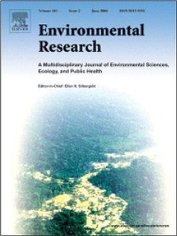Air Pollution and Health
|
|
Age-related lung cell response to urban Buenos Aires air particle soluble fraction
Exposure to particulate matter (PM) may alter lung homeostasis inducing changes in fluid balance and host defense. Bioavailability of soluble PM compounds like polycyclic aromatic hydrocarbons (PAHs), polychlorinated biphenyls (PCBs), and transition metals has been shown to play a key role in lung injury. We have previously characterized the size, shape, and chemical components of urban air particles from Buenos Aires (UAP-BA) and their biological impact on lungs. Herein, we evaluate the possible toxic effect of UAP-BA-soluble fraction (UAP-BAsf) on pulmonary cells obtained from young (1-2 months old) and aged (9-12 months old) Wistar rats using phagocytosis, oxidant-antioxidant generation, and apoptosis as endpoints. UAP-BA were collected in downtown BA and residual oil fly ash (ROFA), employed as a positive control, was collected from Boston Edison Co., Mystic Power Plant, Mystic, CT, USA. Both particle-soluble fractions (sf) were employed at concentrations ranging from 0 to 100 microg/mL. UAP-BAsf and ROFAsf even at the lowest dose assayed (10 microg/mL) showed in both lung cell populations the ability to stimulate phagocytosis and increase superoxide anion (O(2)(-)) generation. Both types of air particles caused a marked intracellular oxidant stress in aged pulmonary cells that may contribute to subsequent cell activation and production of proinflammatory mediators, leading to cell dysfunction. These data suggest that the impact of UAP-BAsf on phagocytosis, oxidant radical generation, and apoptosis is clearly dependent on the maturational state of the animal and might have different mechanisms of action.
|
Effect of particulate air pollutants on individuals of different age groups
Numerous epidemiological studies have associated episodes of high concentrations of particulate matter with increases in hospital admissions and cardiorespiratory diseases. Current effort is focused on identifying the components and characteristics of particulate matter, and on identifying the mechanisms by which this material exerts its adverse effects on health. Particulate matter does not affect the entire population in the same way, there are several factors that determine different degrees of susceptibility to environmental pollution. Age is one of the most important factors. In order to study the effect of air particulate matter on individuals of different age groups, lung cells obtained by bronchoalveolar lavage of young (1-2 months) and adult (8-9 months) male Wistar rats were incubated for 2 hs. at 37°C with different concentrations of ROFA (Residual Oil Fly Ash) soluble fraction (0-200 g/ml), particulate material with marked adverse effects on health. A partial study with air particulate matter collected in the city of Buenos Aires (UAP-BA) was also carried out. The current model that attempts to explain the harmful effects of air particulate matter with an average aerodynamic diameter of less than 2.5 μm, is based on the capacity of these pollutants to produce or induce the production of free radicals. For this reason, this work focused on the study of the oxidant-antioxidant balance in the proposed experimental model. The effect of ROFA (ROFAsf) and UAP-BA (UAP-BAsf) soluble fractions on cell viability, apoptosis and phagocytosis was also studied. ROFAsf caused necrosis at a concentration as low as 10 g/ml in cell populations from young and adult animals. Cell viability was dependent on the dose of ROFAsf and dropped to approximately 70% in both cell populations when they were incubated with 200 μg/ml. ROFAsf induced an increased production of reactive oxygen species (ROS), with a greater effect on cells from adult animals. On the other hand, the antioxidant capacity in adults turned out to be half of the one corresponding to the young individuals. ROFAsf (200 μg/ml) caused a significant increase in the rate of apoptosis of both cell populations, but at levels that probably are not of biological importance. Finally, phagocytic activity was significantly higher in adults than in young animals: exposure to 200 μg/ml of ROFAsf induced a 20% increase in the cell population from adult animals. On the other hand, 10 μg/ml of UAP-BAsf caused an increase in the production of reactive oxygen species (1.5 times higher in adults than in young individuals), whereas it did not produce significant changes on the rates of apoptosis and phagocytosis. These results indicate that cells from adult animals are more susceptible to exposure to ROFAsf and UAP-BAsf, and that a lower antioxidant capacity of these cells determines the early occurrence of states of oxidative stress. Oxidative stress is considered a fundamental factor in the generation of inflammatory processes, and this would probably be the cause of the greater susceptibility of the elderly subpopulation to develop cardiorespiratory diseases.
|


